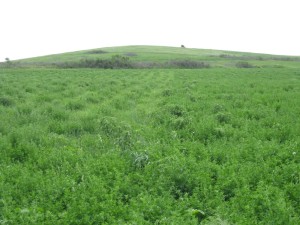A Landowner’s Guide to the Conservation Reserve Program (CRP)
 When it comes to deriving an income from their farmland, landowners have a variety of options from which to choose. For many, farming it themselves is suitable. For others, leasing their land to others to farm is a good option. Another alternative for many landowners is to enter some of their land into the Conservation Reserve Program (CRP).
When it comes to deriving an income from their farmland, landowners have a variety of options from which to choose. For many, farming it themselves is suitable. For others, leasing their land to others to farm is a good option. Another alternative for many landowners is to enter some of their land into the Conservation Reserve Program (CRP).
The Conservation Reserve Program is a land conservation program that offers an annual rental payment and cost-sharing to landowners who agree to remove the selected piece of land from agriculture production and agree to incorporate certain types of beneficial plant species to the land. The CRP’s long term goals are to improve environmental and water quality, prevent soil erosion, and improve natural wildlife habitat. A typical CRP contract lasts 10-15 years.
The CRP is administered through the local Farm Service Agency (FSA) office. The USDA periodically holds a general signup for entering land into the program on a competitive basis, based upon environmental ranking and cost. The general sign up is announced by the Secretary of Agriculture, but there is no set schedule.
Additionally, the USDA offers a continuous CRP signup, known as the CCRP, which offers farmers and landowners payment for more specific land improvements, such as contoured grass strips, riparian buffers, grass waterways, and the like. These improvements, chosen by the farmer or landowner, may be adopted and implemented on the selected parcel of land at any time, hence the name “continuous” sign up.
The Conservation Reserve Enhancement Program (CREP) exists as well. In the CREP, the state offers funding in addition to federal CRP funds to farmers and landowners in order to address more targeted environmental issues within the state.
The benefits of the CRP for landowners as well as the improvements to the nation’s environmental quality are wide-ranging. There are myriad success stories throughout the state of Nebraska and across the nation as a whole. Thanks to the voluntary participation by farmers and landowners, vast improvements have been made to soil and water quality, as well as to wildlife populations and habitats.
To be eligible for the CRP, a farmer or landowner must have owned or operated the land for at least 12 months prior to the previous sign up period, with the exception of land that has been acquired due to the previous owner’s death, a change in ownership as the result of foreclosure, or any land that was purchased by the new owner without the sole intention of placing it in CRP.
For the CCRP, you may sign up at any time. The annual rental income offered through the CRP, in addition to the improvements to the quality of your land, are two important reasons to consider the Conservation Reserve Program. If you are a landowner looking to find additional ways to maximize your land income, and think that entering some of your land into the CRP sounds like a good option for you, contact a UFARM Land Manager for help evaluating your options.
United Farm and Ranch Management (UFARM) is a Nebraska-based company devoted to meeting landowners’ needs. UFARM offers a full range of Nebraska land management services, including real estate sales, rural property appraisals, consultations and crop insurance. UFARM has operated in Nebraska since the early 1930’s.
Sources: “What is the Conservation Reserve Program?” Farm Service Agency. USDA. 02 May 2014. Web. 12 May 2014.
“Conservation Reserve Program.” National Sustainable Agriculture Coalition. Sustainable Agriculture. Web. 12 May 2014.

